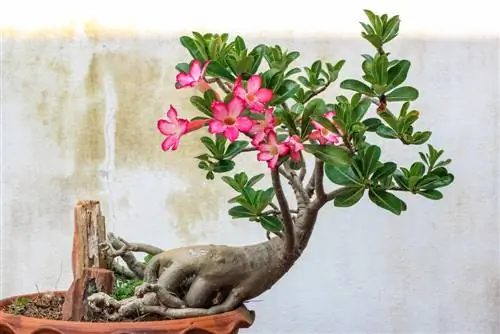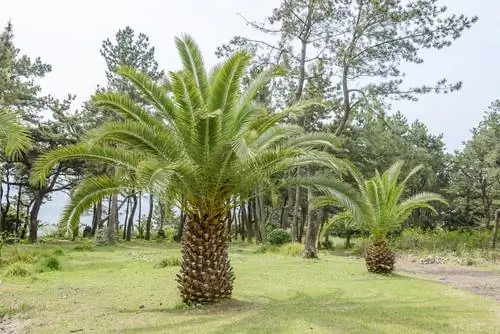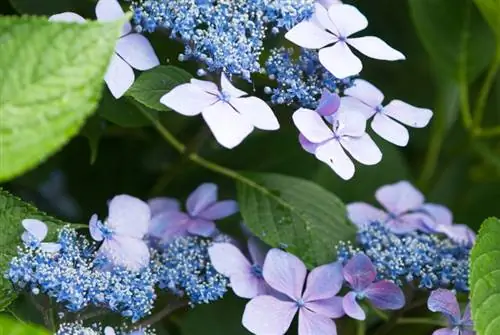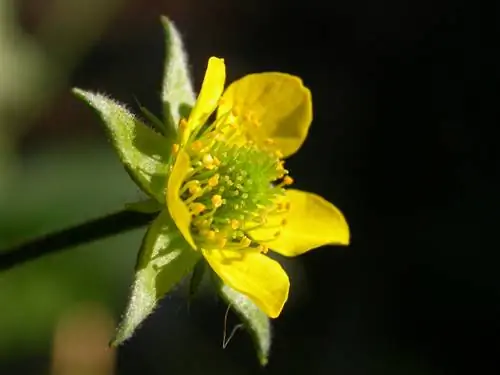- Author admin [email protected].
- Public 2023-12-25 17:45.
- Last modified 2025-01-23 11:21.
The desert rose is an extremely pretty and undemanding ornament for the home windowsill - and yet rather a rarity among amateur gardeners. We have put together everything you need to know about African beauty.
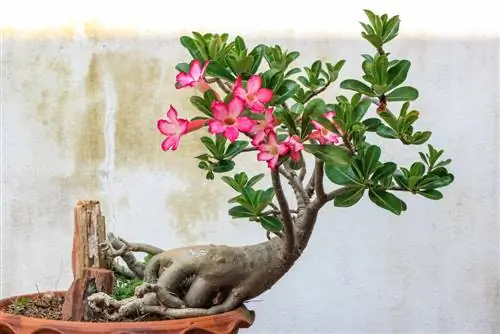
How do you care for a desert rose?
The desert rose (Adenium) is an easy-care houseplant from African and Arabian steppes that is popular for its rose-like flowers and thick, water-storing trunk. It requires a sunny location, little water, occasional fertilization and does not tolerate temperatures below 10°C in winter.
Origin
The desert rose, botanically adenium, is actually not a rose at all - it belongs to the dogpoison family. It owes its beautiful name to its rose-like flowers, which delight with their splendor even in hot, dry conditions. The plant is adapted to such environmental conditions - its habitat is a semi-arid, i.e. a climate that is characterized by long dry seasons. Specifically, the desert rose is native to the steppes of Africa and Arabia.
Which location is suitable?
For cultivation in our latitudes, this means that the desert rose needs a sunny, warm location. It thrives best in a bright spot on the windowsill and can also practically cope with intense sunlight and heat. However, you should turn it a little every now and then so that it doesn't grow at an angle towards the side facing the light. In summer you can and should put them outside, because the light output is definitely greater here than in the room. In winter you have to ensure that your ambient temperature does not fall below 10°C.
Desert Rose Location Rules to Remember:
- Warm and sunny place
- Turn occasionally for balanced, straight growth
- Can/should also be placed outdoors in summer
- In winter no ambient temperatures below 10°C
Growth
The desert rose is classified as a shrub, but it grows as a trunk succulent. It therefore forms a caudex, a heavily woody trunk, which means that its habitus is rather tree-like. The caudex is used for effective, long-term water storage and makes the desert rose a real plant camel because it can easily survive long dry phases. The water storage capacity makes the trunk very thick and the thickening in the lower area creates a striking overall appearance.
In the wild in its original home range, the trunk of the desert rose reaches a diameter of up to 2 meters. It reaches a height of up to 5 meters, but in Central Europe it remains smaller due to the lower availability of light and heat. It grows very slowly and reaches a Methuselah age of several hundred years.
The growth characteristics of the desert rose at a glance:
- Stem succulent with water-storing caudex stem
- Therefore striking appearance and very drought-resistant
- In the wild it reaches a height of up to 5 m and a trunk diameter of 2 m
- Slow growth
- Reaches several hundred years of life
Bloom
The desert rose owes its name to the attractive, pink to reddish, white or purple cupped flowers. Their shape also shows their close relationship with the oleander. They are terminal, five-fold and tube-shaped and intensify their color towards the outside. The flowers are relatively large with a diameter of up to 5 centimeters. They appear in late spring to early summer, around April to July.
leaves
The leaves of the desert rose are also quite attractive with their fingered structure and rich green and give the plant an exotic look thanks to their leathery texture in addition to the grotesque-looking caudex trunk. The leaves are clustered at the ends of the shoots and are around 5 to 15 cm long. The shape of the individual leaves is inverted ovoid and entire. In its home area, the desert rose is almost evergreen, but in this country it sheds its leaves during the winter rest phase.
Watering desert rose
As a trunk succulent, the desert rose makes watering work easy for the hobby gardener. Since she can store so much water in her caudex, you can feel free to forget about her or go on vacation for a few weeks without organizing a watering replacement. In general, it gets by with little water; waterlogging is much more critical than a lack of water. It can lead to root and trunk rot and must be avoided at all costs.
Over the winter you hardly have to and shouldn't water at all - that would counteract the lack of light. After the winter break, you should only gradually get them used to more water again.
To remember:
- Desert rose needs little water
- Can survive for a long time without watering due to caudex stem
- Avoid waterlogging at all costs
- Hardly watering necessary in winter
Wintering
The dwindling light available in our Central European winter inevitably means a period of rest for desert rose culture. However, you should not put it in the dark, but rather leave it in a bright window seat. Due to its vegetative break, it also needs cooler temperatures in winter, although these should not fall below 10°C. A good location is a windowsill in a room that is not too warm. It is important to water little or not at all - too much vegetation growth through watering can prevent flowering in the following spring and summer!
The wintering rules for the desert rose:
- Slightly cooler, but brightly
- No temperatures below 10°C
- Hardly or not at all watering
read more
Fertilize desert rose properly
You can fertilize the desert rose a little throughout the vegetation phase, but at most every 2 weeks. To do this, use a fertilizer with balanced potassium, phosphorus and nitrogen values.
Loses leaves
Although the desert rose is almost entirely evergreen in its homeland, here it loses its leaves over the course of autumn. This is completely normal as it needs a period of rest in view of the fading light. So you don't have to worry about shedding leaves in October.
However, if the desert rose sheds its leaves in the light-rich vegetation phase, this is worrying. In this case, different factors may be to blame. The most likely ones are:
- Inconvenient location
- Change of circumstances too quickly after winter break
- Waterlogging
- Overfertilization
Inconvenient location
The site conditions are unfavorable for the desert rose if they are too dark or too drafty. Always make sure that the African plant gets lots and lots of sun. She also doesn't like draughts.
Change of circumstances too quickly after the winter break
Due to its slow metabolism, the desert rose needs to be gently and slowly accustomed to the increasing availability of light and more water after the winter break. If possible, avoid a radical start to the vegetation phase by immediately placing it in the blazing sun in spring and trying to force it to sprout and flower with vigorous watering. Instead, it's better to initially put it in a slightly brighter place and start watering very gradually.
Waterlogging
A substrate that is too wet is bad for the desert rose. Always make sure that the substrate is not permanently wet and remember that the plant stores enough water in its trunk. Root and stem rot can not only lead to temporary leaf loss, but can also permanently damage the plant.
Overfertilization
You must not overwhelm the desert rose when fertilizing either. As a slow-growing steppe plant, it only needs a small amount of fertilizer every 14 days during the vegetation phase. If the fertilizer is too much or too aggressive, the desert rose can easily burn.read more
Cut desert rose correctly
The cutting chapter is quickly ticked off with the desert rose: Due to its slow growth and moderate branching, it doesn't need any pruning care at all.
If you really want a special form of training, perhaps in the direction of bonsai culture, you can of course work on the desert rose with cutting tools - but they should be well sharpened and hygienically clean. It usually grows well again from cuttings. Under no circumstances, however, should the caudex be injured, which as a water reservoir is the elixir of life for the desert rose.read more
Repotting
When the desert rose has bloomed for the first time, it is recommended to repot it in the following early spring. As a substrate, use a simple mixture of commercial houseplant soil and a good proportion of sand. In the following years you only need to repot the plant if the pot becomes too crowded.read more
Propagation
Do you want to propagate your desert rose? This is relatively easy to do with cuttings. This method is particularly recommended because the desert rose grows so slowly. When growing cuttings, you don't have to wait so long for a fully formed plant and the first flower. To do this, cut a medium-long shoot and put it in a pot with potting soil that you place in a bright, warm place. For rooting, keep it evenly moist and, if necessary, cover it with foil.read more
cultivation
Growing a desert rose from a seed is a little more time-consuming. However, patience pays off in several ways: In contrast to a cutting, a plant with a much better developed caudex develops from a seed - so you can expect a specimen with all the characteristic features. The desert rose seeds also show good germination ability. The flower color will often revert to the original shade of pink - with this method, unlike the cutting variant, you don't get a clone.
When planting the seed, you must be careful not to get it too deep below the surface of the soil. It may only be covered by a centimeter at most. To germinate, place the growing pot in a place that is as bright and warm as possible and keep the substrate evenly moist. As a rule, it only takes one to one and a half weeks for the seedling to appear. When it has reached a height of around 10 centimeters, transfer it to a new pot with cactus soil and continue to cultivate it according to the species-appropriate care rules. It takes at least two years for the desert rose grown from seed to bloom for the first time.
Overview of seed cultivation:
- Preferable to the cutting method if a specimen with a fully developed caudex is desired
- High success rate due to good germination ability
- Do not place deeper than 1 cm in the soil
- Warm, bright growing location
- Time until the first flowering: at least 2 years
read more
Diseases
Fortunately, the desert rose is quite resistant to diseases and pests. Spider mites or mealybugs can occasionally appear in a heated room. However, these can be easily combated by showering and, if necessary, spraying with an oily mixture or nettle broth.
Is desert rose poisonous?
The fact that the desert rose belongs to the dogpoison family says it all: it is poisonous, in all parts of the plant. In households with small children and animals that like to nibble on houseplants, it should be avoided as much as possible. The milky plant sap, which was also used as arrow poison by locals in their homeland, is particularly highly toxic. The toxic cardenolides are highly concentrated here and, when consumed, cause mucous membrane irritation, nausea and vomiting, cramps and circulatory disorders up to life-threatening cardiac paralysis.read more
Varieties
The best-known variety of desert roses is Adenium obesum. There are also 5 to 15 other varieties that are cultivated as ornamental plants in this country. Here is a small selection:
Adenium obesum
This most common species is most often found in plant centers, although there are also some subspecies with names such as A. honghel, A. Coetaneum or A. Somalense. They have different flower colors from white to dark pink and have varying characteristics in appearance such as particularly corky bark or differentiated branching. It grows to a height of around 3 meters in pots when grown indoors and outdoors and requires a lot of sun and warmth.
Adenium arabicum
This variety is quite close to Adenium obesum, but is considered the most suitable desert rose for bonsai cultivation. Its caudex is slightly more pronounced than that of Adenium obesum and its leaves are particularly large. Their flower colors vary between pink, clear red and deep purple with fire-colored centers. The Adenium arabicum is often sold in the form of seeds, which opens up a free design spectrum for bonsai lovers.
Adenium multiflorum
The Adenium multiflorum has its most important feature in its name: its flowers are particularly rich and colorful, with the colors varying between pink, pink tones or mauve shades depending on the specimen. The joy of flowers is further enhanced by a pleasantly sweet scent. Its leaves are up to 10 cm long and shiny dark green. Unfortunately, this variety has neither leaves nor flowers for most of the year. Overall, the Adenium multiflorum reaches a height of between half and 3 meters.
Adenium oleifolium
In German, this variety is called olive-leaved desert rose and has corresponding foliage with 4-13 mm long, olive-green leaves. In terms of size, it is the smallest desert rose variety with a maximum height of only around 30 to 45 centimeters. Its flowers appear in pink, salmon-colored to reddish tones.
Adenium swazicum
The Adenium swazicum comes from Swaziland and is a small exception among the desert roses in terms of location: it likes a bit of partial shade and doesn't necessarily need as much sun as possible like the other varieties. Adenium swazicum is also one of the smaller desert rose varieties with a maximum height of 45 to 60 centimeters. Compared to Adenium obesum, its flowers appear a little earlier in spring and delight with intense pink to magenta tones.

